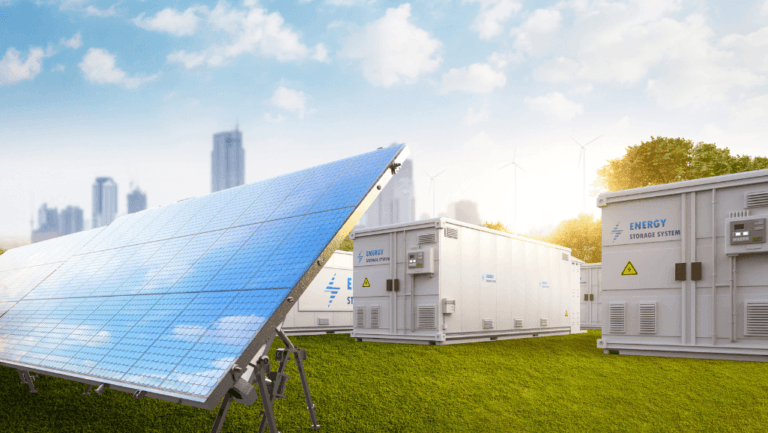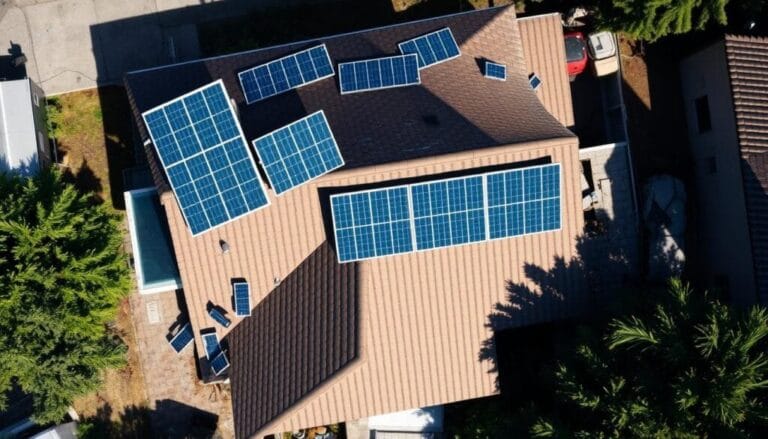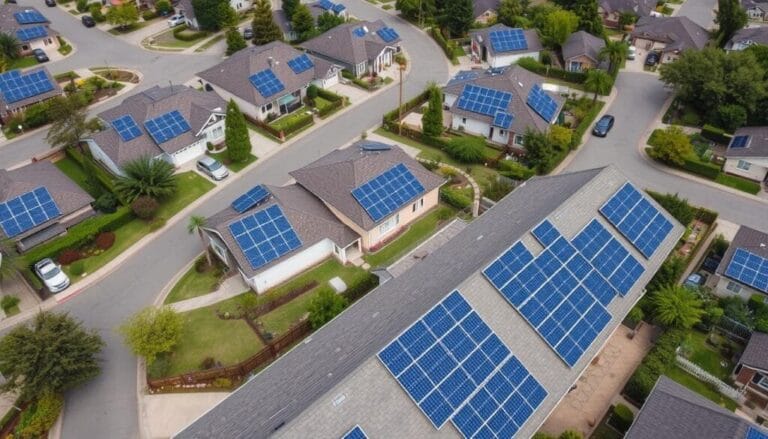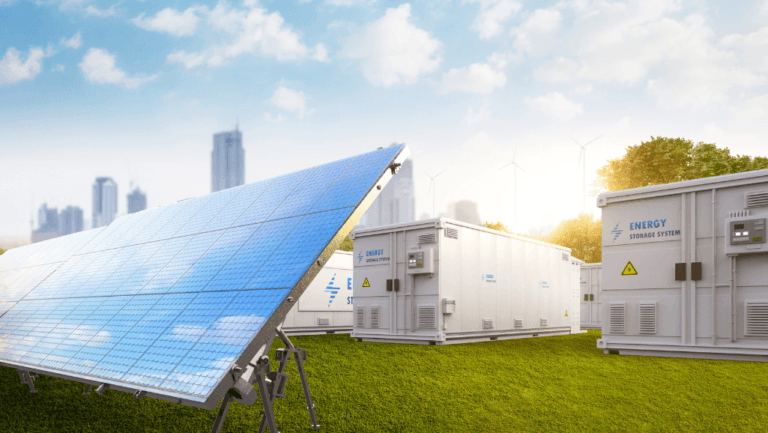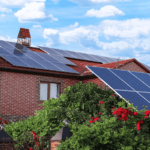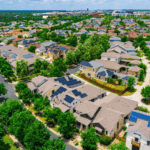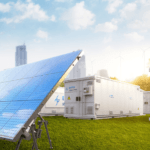Solar energy comes from the sun and is a growing way to make power. It powers millions of homes and a big part of the electricity in the U.S. Knowing the good and bad of solar energy is key.
Solar energy has many benefits. It can lower your electric bills and make your home worth more. It also saves money over time and is good for the planet. But, it has its downsides too. These include high costs to start, needing sunlight, taking up space, and the environmental impact of making and getting rid of solar panels.
Despite the challenges, solar energy is getting more popular. This is thanks to things like the Solar Investment Tax Credit (ITC). It has helped create jobs and boost the economy. As technology gets better and prices drop, more people will likely turn to solar energy. This will help us move towards a greener future.
Key Takeaways
- Solar energy has both good and bad sides. The good includes lower bills, higher home value, and being eco-friendly. The bad includes high costs and needing sunlight.
- The U.S. uses a lot of solar power now, helping many homes and a big part of the electricity supply.
- The Solar Investment Tax Credit (ITC) has helped solar energy grow, creating jobs and economic benefits.
- Improvements in technology will make solar energy cheaper and more efficient, leading to more people using it.
- It’s important to know the pros and cons of solar energy before deciding to use it for your home or business.
Understanding Solar Energy
Solar energy uses the sun’s rays to make electricity. It’s a clean and sustainable way to power our homes and businesses. Solar panels are now easier to get, offering many photovoltaic system benefits to people everywhere.
The sun sends out a lot of energy that we can use. Solar panels work best in sunny places like fields or rooftops. The more sunlight they get, the more electricity they make. Solar panels last 25 to 35 years, saving homeowners $25,000 to over $110,000 over two decades.
How Solar Panels Work
Solar panels have PV cells that turn sunlight into electricity. When sunlight hits the cells, it makes electrons move and creates electricity. This electricity is changed to AC by an inverter for use in homes and businesses. Now, solar panels can turn up to 22% of sunlight into electricity.
Types of Solar Energy Systems
There are three main solar energy systems:
- Grid-tied systems: These connect to the power grid, sending extra energy back. Homeowners get credits for this extra energy.
- Off-grid systems: These stand alone and use batteries for power when the sun isn’t out. They’re great for places far from the grid.
- Hybrid systems: These mix grid-tied and off-grid features. They use batteries for backup during outages but connect to the grid too.
Solar technology has gotten cheaper over the years, making it easier to install solar panels. In the U.S., a 5 kW system costs between $13,250 and $21,000 in 2023. Even though it costs to start, the benefits like lower bills and higher home value make it worth it.
Adding solar can raise a home’s value by about 4%. It also cuts down on harmful gases, making our air cleaner. With a 30% tax credit and state credits like SRECs, going solar is now more appealing financially.
Advantages of Solar Energy
Solar energy is changing the game in renewable energy. It offers many benefits that make it a great choice over traditional energy sources. As we aim for a sustainable future, it’s key to know the perks of solar power. Solar energy is eco-friendly and can save money, changing how we make and use electricity.
Renewable and Environmentally Friendly
Solar energy is both renewable and good for the planet. It’s not like fossil fuels, which run out and pollute. Using the sun’s power helps us use less dirty energy and cut down on pollution. Solar power is cleaner, producing much less emissions than coal or natural gas.
Reduced Electricity Bills
Going solar can really cut down your electricity costs. By making your own power, you use less from the grid. Solar systems have gotten cheaper over time, making solar more affordable. People who get solar panels can save up to £1,005 a year on bills, which is a big help financially.
Low Maintenance Costs
Solar systems are easy to keep up. They don’t need much work, as long as they’re not affected by the environment. Solar panels last about thirty years and don’t lose much power. They come with warranties for 20 to 25 years, giving you confidence. Cleaning them yearly costs between £25 and £35, which is a small price for the long-term gains.
Diverse Applications
Solar energy is very versatile, used for more than just homes and businesses. It can power places far from cities, helping rural areas and remote research stations. It’s even used for making clean water in places where safe water is hard to find.
| Country | Solar Energy Growth (2020) |
|---|---|
| China | 26% |
| United States | 19% |
| Japan | 16% |
| Australia | 22% |
| India | 24% |
The table shows how solar energy is growing worldwide, with India planning to use more renewable energy. This move towards solar power shows its growing popularity and our effort to use clean energy sources.
Disadvantages of Solar Energy
Solar energy has many benefits, but it’s important to look at the downsides before you invest. Even with lower solar panel costs and better technology, there are still hurdles to overcome.
High Initial Costs
The main challenge is the high cost upfront. Solar panel prices have dropped by 54% in 2023. Yet, installing solar in 2024 costs between $18,000 and $20,000 before incentives. This can be a big hurdle for many looking into solar energy.
Weather Dependent
Solar energy depends a lot on the weather. Clouds or rain can cut solar power by about 10%. Places like Denver, Colorado, get 30 to 40 overcast days a year, hurting solar power. In extreme cases, like Hilo, Hawaii, with rain on 277 days a year, solar might not be the best choice.
Energy Storage Is Expensive
To fix solar energy’s ups and downs, you need energy storage like batteries. But these are pricey and aren’t usually under the solar panel warranty. Replacing solar panel batteries can cost over $100 each, making solar more expensive.
| Battery Type | Cost Range |
|---|---|
| Lead-acid battery | $200 – $800 |
| Residential lithium-ion solar system | $7,000 – $14,000 |
Requires Space
Solar panels and wiring take up a lot of space. This can be a problem for those with small roofs or living in tight spaces. Solar setups can also make roof repairs harder and might not look good to everyone.
“The high initial cost and space requirements are two of the most significant solar panel drawbacks that homeowners face when considering a solar installation.”
Despite these issues, solar energy is still a strong choice compared to traditional energy sources. As technology gets better, solar might become cheaper. Improvements in solar panel efficiency and storage could also lessen these problems.
Financial Considerations
Looking at solar energy’s financial side is key. We must think about the upfront costs, savings over time, and incentives. The initial cost of solar panels is high, but the savings on electricity bills and possible returns make it a good choice for many.
Solar Panel Costs
The price of solar panels changes based on the system’s size, location, and how hard it is to install. The Lawrence Berkeley National Laboratory says the average cost for a home system is $3.80 per watt. This means a 7-kilowatt system costs about $26,600 to install. But, the cost can range from $10,000 to $18,000 for a typical system in the US.
Return on Investment
Solar panels offer a good return on investment despite their cost. They can last 20 to 30 years with little upkeep. On average, they can give back about 10% in returns. Plus, homes with solar panels can sell for up to $15,000 more, says the US Department of Energy’s Lawrence Berkeley National Laboratory.
The time it takes to pay back solar panels varies. It’s usually between six to 12 years. This depends on energy costs, how much electricity you use, and the incentives you get, says Jamie Haenggi of ADT Solar. Over the system’s life, homeowners can save a lot on their electricity bills.
Incentives and Rebates
There are many government incentives and rebates to help with the cost of solar panels. Homeowners can get a 30% tax credit for installing a solar system. This tax credit was increased to 30% for systems installed by 2032.
States also offer rebates to lower the cost of solar panels and tax credits. Some electric companies give a subsidy for installing solar systems. These incentives can greatly reduce the cost for homeowners going solar.
| Incentive | Description |
|---|---|
| Federal Tax Credit | 30% tax credit on income taxes for the cost of installing a solar system |
| State Rebates | Rebates to reduce the cost of solar panel installation and tax credits |
| Utility Subsidies | Subsidies provided by electric utility companies for installing a solar energy system |
By using these incentives and looking at long-term savings and returns, people can make smart choices about solar energy. They can enjoy the financial benefits of this renewable energy source.
Environmental Impact
Solar energy is a key solution to lessen the environmental harm from traditional energy sources. It’s important to look at the whole life of solar panels to see their true effect on the planet.
Reduction of Greenhouse Gas Emissions
Solar energy is great because it can cut down a lot on greenhouse gas emissions. Solar panels make electricity without adding to the air pollution. This makes solar power a clean choice.
On the other hand, most power comes from burning fossil fuels like natural gas and coal. These have big health and environmental problems. Solar panels are much better, with emissions about 40 times lower than coal.
Solar energy is also renewable, meaning it won’t run out. The sun’s power is endless, making solar a sustainable energy choice.
Manufacturing and Disposal Concerns
Even though solar energy is good for the environment when it’s working, making and getting rid of solar panels has its problems. Making solar panels uses a lot of energy and creates greenhouse gases. But, solar panels pay back their emissions in just a few years, helping to fix this issue.
When solar panels can’t be used anymore, recycling and getting rid of them safely is key. Some panels go to landfills because recycling isn’t common in the U.S. As more people use solar, we need better recycling options to lessen the harm from old panels.
| Energy Source | Life Cycle Emission Intensity (gCO2/kWh) |
|---|---|
| Solar PV | 40 |
| Coal | 1,000 |
New solar panel technology has made them much better, with some now over 19.5% efficient. This means they use less material to make more energy, reducing their environmental impact.
In conclusion, solar energy is good for the planet by cutting down on greenhouse gases and being renewable. But, we need to work on making and recycling solar panels to lessen their environmental harm even more.
Pros and Cons of Solar Energy
Solar energy is becoming a top choice for those looking for a green and lasting energy source. It’s important to know the good and bad sides of solar power before deciding if it’s right for you. We’ll look at the benefits and drawbacks to help you make a smart choice.
Solar energy is great because it’s endless. The sun always shines, so it’s a steady power source. It’s also good for the planet since it doesn’t release harmful gases or pollutants. This makes it a key player in fighting climate change.
Using solar energy can also cut your electricity bills. By making your own power, you use less from the grid and save money. A study found that saving one dollar on electricity can increase a home’s value by $20. Homes with solar panels sell for about 4.1% more, adding $9,274 to their value.
But, solar energy has its downsides. The main issue is the high cost to start. A five-kilowatt system can be $10,000 to $25,000 or more. Solar panels also lose some power over time, needing replacement after 25 to 30 years.
“Solar power is the third largest renewable energy source, growing fast. In 2023, most new renewable energy came from solar, says the International Energy Agency.”
Solar power relies on the weather. It works best in sunny places and can be less effective in cloudy or winter months. Using solar storage batteries can help, but they add more cost. A full solar-plus-storage system can be $25,000 to $35,000, and a separate battery system costs $12,000 to $22,000.
Space is another thing to think about with solar energy. You need a lot of room for enough panels to power a place. The Botley West farm in Oxfordshire will cover five square miles and power 330,000 homes. While rooftop panels can help, not every home has enough space or the right setup for solar panels.
| Pros of Solar Energy | Cons of Solar Energy |
|---|---|
| Renewable and environmentally friendly | High initial installation costs |
| Potential for reduced electricity bills | Weather-dependent |
| Increases home value | Solar panels lose efficiency over time |
| Low maintenance costs | Energy storage is expensive |
| Diverse applications | Requires significant space |
In conclusion, solar energy has many benefits but also some drawbacks. Think about costs, space, and weather before deciding. Weighing these factors and your energy goals will help you see if solar power is right for you.
Solar Energy for Homes and Businesses
Solar energy is now a top choice for homes and businesses. It’s a green and cost-saving way to power up. Thanks to tech advances and lower costs, more people are going solar. The U.S. has 179 Gigawatts of solar power, enough for 33 million homes. Solar power has grown by 22% each year for the past decade.
Residential Solar Installations
Homeowners can save a lot with solar panels. They can cut their bills by $1,000 to $2,000 a year. In some states, savings can hit up to $3,000 a year with a big system.
A 6-kW system costs about $17,100 but drops to $11,970 after a 30% tax credit. Over time, these savings add up, paying off the system in 6-9 years. Solar panels also boost a home’s value by up to $15,000, says the Department of Energy.
Homeowners can get help with the upfront cost through incentives and rebates. The solar tax credit gives 26% off the system’s cost. Many states offer more help to encourage solar use. By going solar, homeowners save on bills and help the planet by using less fossil fuel.
This article on solar energy benefits shows solar is a clean energy source. It doesn’t release harmful gases, making it good for the planet.
Commercial Solar Applications
Businesses gain a lot from solar energy too. They can save $100,000 to $350,000 on energy costs over 30 years. More U.S. buildings, 3.5%, now have solar panels, and 1% are in community solar programs.
A 50 kW to 100 kW system costs $130,000 to $250,000. But with tax credits and other incentives, costs can drop by up to 70%.
Solar energy gives businesses a competitive edge. It shows they care about the environment. This draws in customers who value green initiatives.
Businesses can make money by selling extra solar energy back to the grid through net metering. This article on solar for businesses explains the benefits and what to consider.
| Solar Energy Benefits | Residential | Commercial |
|---|---|---|
| Annual energy savings | $1,000 – $3,000 | $100,000 – $350,000 over 30 years |
| Property value increase | Up to $15,000 | 4-7% |
| Federal tax credit | 26% of total system cost | Up to 70% reduction in installation costs |
| Payback period | 6-9 years | Varies based on system size and incentives |
The table shows solar energy helps both homes and businesses. It cuts costs, increases property values, and offers tax breaks. With growing demand and lower costs, solar energy is key for powering homes and businesses in the future.
Future of Solar Energy
The future of solar energy is looking up, thanks to new tech and more people using it. This is great news for our planet as we face climate change and need clean energy. Solar Powers World is leading the way with the latest on solar tech and its big impact on our energy use.
Technological Advancements
Technological progress in solar energy is moving fast. Scientists and engineers are making solar panels and storage better and cheaper. Some exciting new ideas include:
- Perovskite solar cells, which could be cheaper and more efficient than old types
- Concentrator photovoltaics, using mirrors to focus sunlight on high-efficiency cells
- Bifacial solar panels, catching sunlight from both sides for more power
- Advanced energy storage like flow batteries and molten salt for storing solar energy
These new solar tech improvements are making solar panels better and cheaper for everyone. Soon, solar panels might get up to 30% efficient, which could help us use solar energy a lot more.
Increasing Adoption
More people, companies, and governments are choosing solar power over fossil fuels. The International Energy Agency says solar could make up 27% of the world’s electricity by 2050, up from 2% now.
This shift is happening for many reasons, like:
- Government support for renewable energy
- People wanting clean energy options
- Lower solar panel costs making it more affordable
- Easy financing options like solar leases
As more adopt solar energy, it’s becoming a key part of our energy mix. Countries like China and the U.S. are investing a lot in solar, showing a bright future for it.
| Country | Installed Solar Capacity (2020) |
|---|---|
| China | 253 GW |
| United States | 76 GW |
| Japan | 67 GW |
| Germany | 53 GW |
| India | 39 GW |
In summary, solar energy’s future looks great with new tech and more people using it. It’s set to play a big role in fighting climate change and meeting our energy needs.
Conclusion
Solar energy is the clear choice for those looking for a sustainable energy source. It can cut a household’s carbon footprint by up to 1.5 tonnes a year. Homeowners can save thousands on their electricity bills too.
The cost of solar panels has dropped by over 70% in the last ten years. This makes solar power more affordable for both homes and businesses. It’s a great option for anyone wanting to switch to renewable energy.
Installing solar power can cost between $18,000 and $20,000 for an average American home. But, the savings and low upkeep make it a smart choice. You can get a tax credit for 30% of the cost, and sell extra energy to the grid for extra cash.
This can bring in $50 to over $700 a month, depending on where you live. Solar panels can last up to 25 years without losing power, giving you reliable, sustainable energy for a long time.
As technology gets better and more people use solar energy, its future looks bright. Solar panels are getting more efficient, with rates of 15-20%. Some solar cells even hit around 40% efficiency. By choosing solar, you help make the planet cleaner and can save money on energy bills and increase your property’s value.






